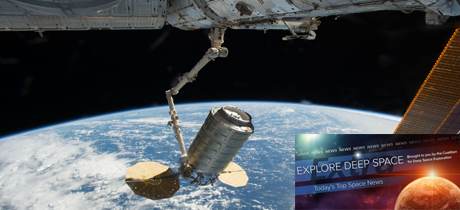In Today’s Deep Space Extra… Orbital ATK Cygnus cargo mission reaches the International Space Station. Launching of NOAA’s JPSS-1 advanced weather satellite from Vandenberg Air Force Base, California, is delayed until early Wednesday.
Human Space Exploration
Cygnus cargo ship delivers holiday goodies and science gear to Space Station
Coalition Member in the News (Orbital ATK)
Space.com (11/14): Orbital ATK’s eighth NASA contracted Cygnus resupply capsule rendezvoused with the International Space Station early Tuesday. European and U.S. astronauts Paulo Nespoli and Randy Bresnik teamed to grapple the Cygnus capsule named for the late Apollo 17 commander Gene Cernan at 5:04 a.m., EST, using the Station’s Canadian robot arm. The capsule and its 7,400 pound cargo of crew supplies, science experiments and technology demonstration lifted off early Sunday from NASA’s Wallops Island Flight Facility on Virginia’s Eastern Shore.
His very own asteroid: Space rock named for Italian astronaut
Space News (11/13): European Space Agency astronaut Luca Parmitano is the namesake for an asteroid, 37627 Lucaparmitano, also known as 1993 TD. The asteroid was discovered nearly a quarter century ago by an Italian astronomer.
Space Science
Rocket issue delays launch of advanced new JPSS-1 weather satellite
Space.com (11/14): NASA delayed the launch of NOAA’s advanced JPSS-1 weather satellite from Vandenberg Air Force Base, California, early Tuesday in response to a technical issue with the Delta II rocket during the 66 second launch window. The launching was reset for Wednesday at 4:47 a.m., EST.
NASA’s James Webb Space Telescope early science observations revealed
NASA/Goddard (11/13): Astronomers globally have settled on some early targets for observations with the James Webb Space Telescope, which is planned to be launched in late 2018 as a successor to the Hubble Space Telescope. Those early targets include Jupiter and its many moons and infant galaxies in the early universe.
Privately funded team may launch life-hunting mission to Saturn moon Enceladus
Space.com (11/13): Yuri Milner, the wealthy Russian tech investor, is considering a privately funded mission to investigate the habitability of Saturn’s ice and ocean covered moon Enceladus. Milner’s spacecraft would fly through a geyser like spray coming from the moon, collect a sample and analyze the material for evidence of a habitable environment.
Other News
An open letter to Vice President Pence and the National Space Council on space traffic management
The Space Review (11/13): There’s an urgent need to establish a federal agency to manage space traffic, three long time veterans of U.S. space operations urge in an op-ed. The recent re-established White House National Space Council offers the perfect opportunity, they write.
Minute-long free flight moves Dream Chaser closer to Florida launch, landing
Florida Today (11/14): Sierra Nevada Corp. reports a satisfactory glide test of its winged, reusable Dream Chaser spacecraft over the weekend at Edwards Air Force Base, California. An engineering version of the spacecraft Sierra Nevada is developing to deliver and retrieve cargo from the International Space Station under a NASA contract was lifted by helicopter to an altitude of 3,730 meters and released to glide to the runway. Dream Chaser is to carry out Space Station resupply missions between 2019 and 2024, launching from and landing at Cape Canaveral, Florida.
What happens if China makes first contact?
The Atlantic (12/1): China has embarked on a search for extra-terrestrial intelligent life with the construction of a remote radio observatory, twice as large as the Arecibo radio telescope in Puerto Rico. Chinese science fiction writer Liu Cixin, however, is among those who warn a telltale search threatens to bring harm to the Earth.
Virgin Galactic wants to send people on superfast trips across Earth
Space.com (11/13): Speaking in Seattle, Virgin Galactic CEO George Whitesides said the company’s future may reside in rapid point to point travel on Earth through suborbital flight. The company’s founder, Richard Branson, raised the prospect publicly just a month ago. Whitesides elaborated at a Seattle summit called “A New Space Age.”

